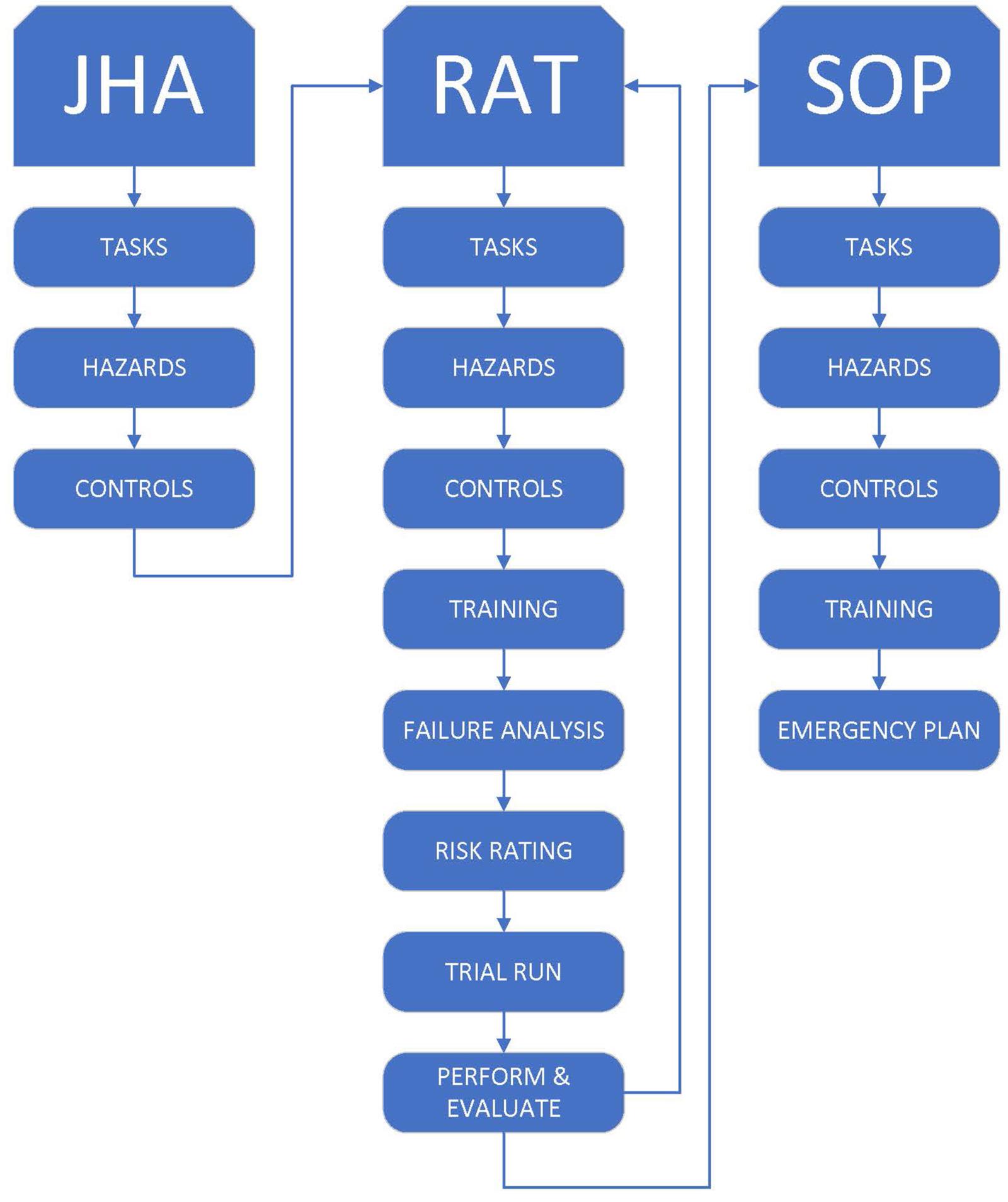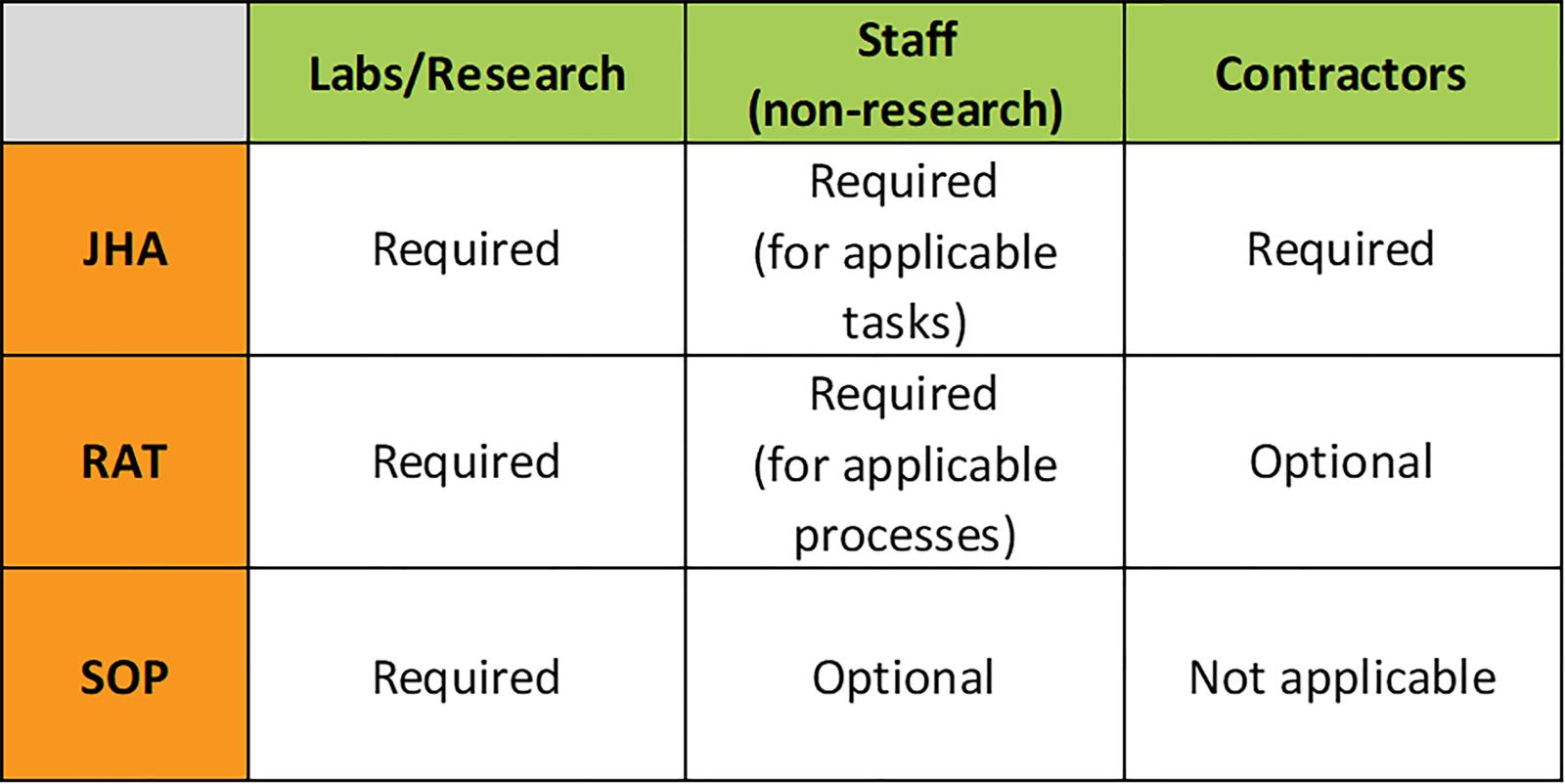The purpose of the UT Austin injury and illness prevention program (IIPP) is to promote and maintain a safe and healthy work environment for all of campus. This program aims to prevent workplace injuries, illnesses, and fatalities by identifying potential hazards and taking measures to control or eliminate them. An effective IIPP involves establishing safety policies and procedures, providing training and education to workers, conducting regular workplace inspections, and investigating incidents and near misses to determine their root causes. By implementing an IIPP, UT Austin can not only protect the well-being of students and employees but also improve productivity, reduce absenteeism, and avoid the financial and legal costs associated with workplace injuries and illnesses.
Risk Assessment & SOP Library
This section is designed to provide a central location for resources related to job hazard analysis, risk assessment templates, and standard operating procedures. The information contained within this library is intended to help you manage workplace risks and ensure compliance with EHS regulations and standards. The Risk Assessment & SOP Library contains a collection of documents and templates that can be used to identify potential hazards, evaluate the associated risks, and establish effective control measures. By utilizing the resources available on this page, you can improve the safety and health of your workplace and prevent workplace injuries and illnesses.
Hazard Identification and Control
The Job Hazard Analysis (JHA), Risk Assessment Tool (RAT), and Standard Operating Procedure (SOP) process flow is an interdependent framework that helps ensure workplace safety. Each step of the process relies on the previous one, creating a comprehensive approach to hazard identification and control. The JHA provides the foundation for the risk assessment, which in turn informs the development of effective control measures in the SOP. By completing a JHA, you can identify the specific hazards associated with a job, while the risk assessment helps you evaluate the likelihood and severity of those hazards. This information is critical for developing effective control measures that are outlined in the SOP. By following this process flow, you can create a safe and healthy workplace that minimizes the risks associated with job-related hazards.

Applicability and Expectations
The JHA, RAT, and SOP are essential tools for managing workplace risks and ensuring compliance with EHS regulations and standards. However, the requirements for completing these documents can vary depending on the job and the group of employees involved. To help clarify the requirements for completing these documents, please see the table below. This table can be used as a reference to ensure that all necessary steps are taken to manage workplace risks and create a safe and healthy work environment.
-

These documents do not typically require EHS review and approval before they can be implemented. Instead, they are considered "living documents" that should be kept on file internally within the department conducting the work/research. This means that those performing the work and managing the risks should have access to these documents and be familiar with their contents. While EHS professionals may provide guidance and support in the development of these documents, they do not typically have a formal review and approval role. This is because these documents are intended to be practical tools that can be quickly and easily updated to reflect changes in the work environment or new information about hazards and risks. By keeping these documents up to date and easily accessible, departments can effectively manage workplace risks and maintain a safe and healthy work environment.
SOP Library
SOPs are an essential part of an effective Injury Illness Prevention Program. SOPs provide step-by-step instructions for carrying out specific work activities, while also outlining the necessary safety precautions and hazard controls. The SOP library offers a comprehensive collection of SOPs that cover a wide range of work activities and hazards, providing a valuable resource for researchers, managers, supervisors, and employees and access to tried-and-true procedures that have been successfully implemented in a variety of work environments. These completed templates can be easily adapted to suit the unique needs of your workplace, helping you to create a safer and more efficient work environment. Additionally, the blank templates provide a starting point for those who are just beginning to develop their own SOPs. All SOPs are developed in accordance with UT Austin EHS guidance, and are regularly reviewed and updated to ensure their continued relevance and effectiveness.
If you would like to add your completed template to the SOP Library:
-
- Email your completed template to both the EHS Occupational Safety Manager and the Laboratory Safety Manager.
- EHS will review, approve, and upload your completed template.
- Share the link to your completed template with your colleagues.
SOP Library (UT BOX)
-
